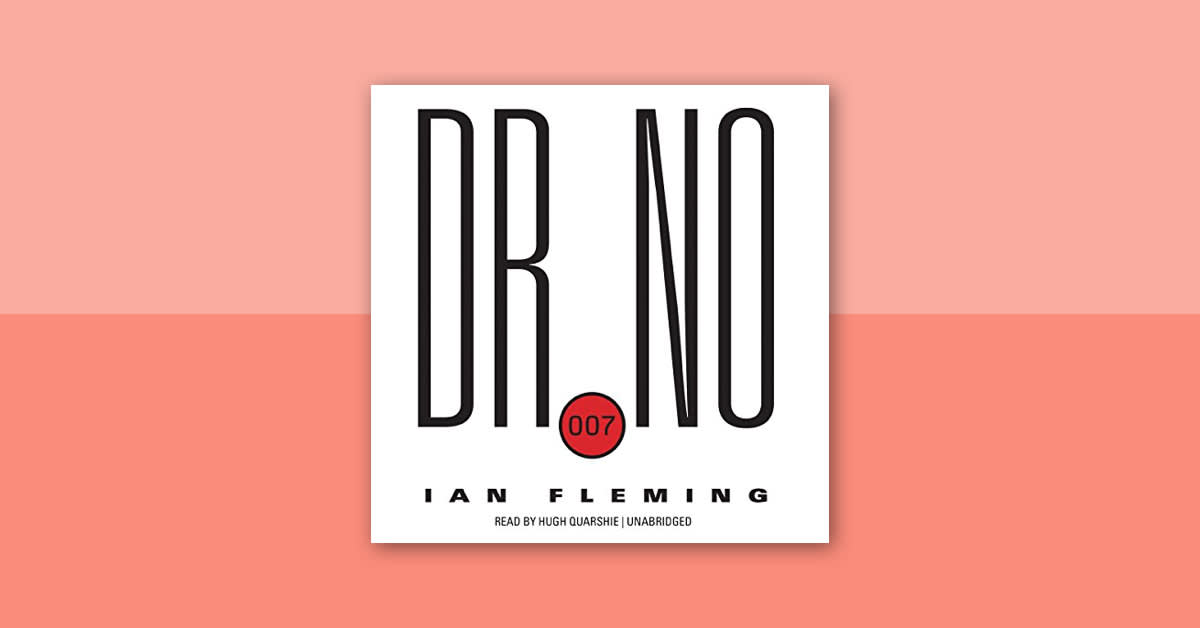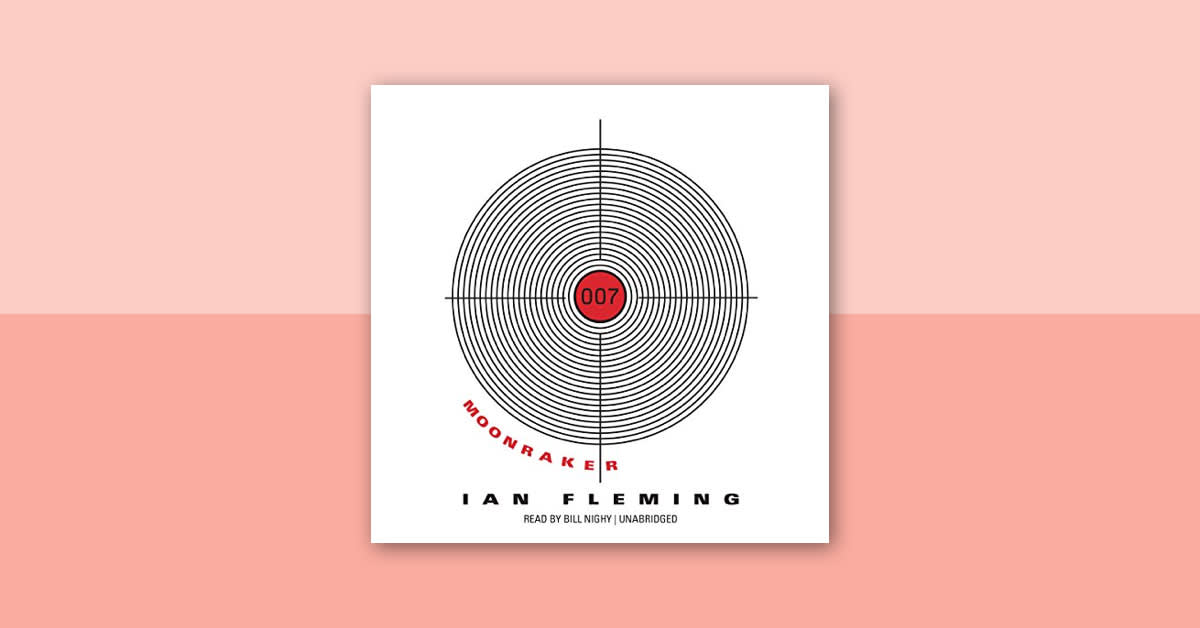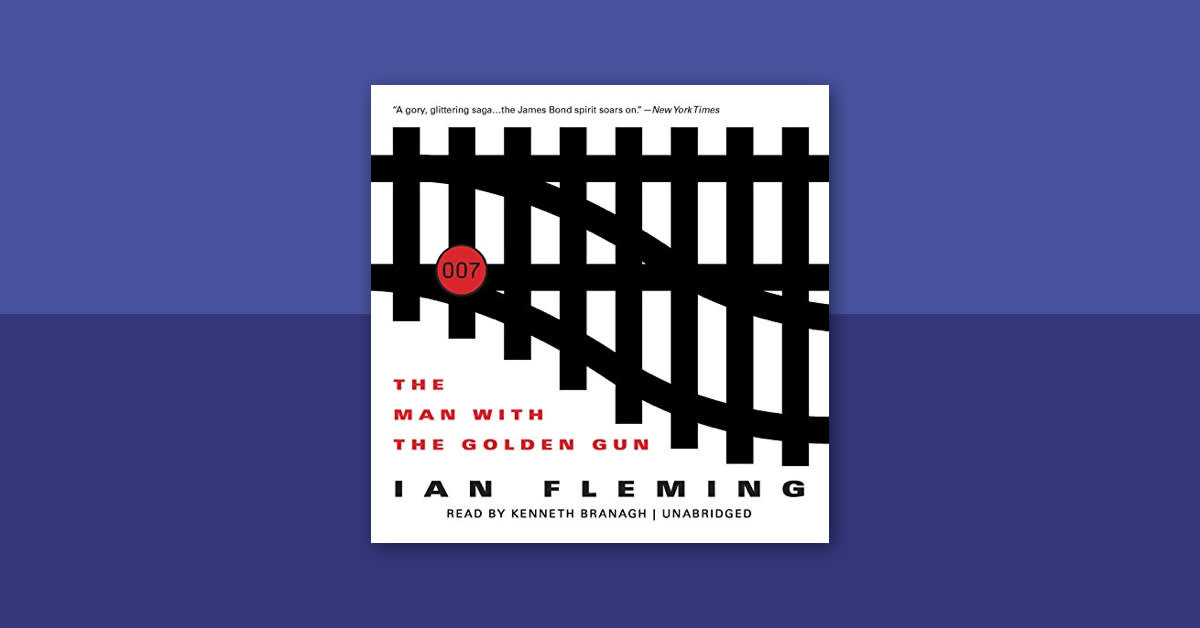Even if you’ve never seen a James Bond movie or listened to one of Ian Fleming’s thrilling Bond novels, you likely know a little something about the world’s most famous spy. You know his code name is 007, and you're familiar with his passion for fast cars and gadgets. And it’s probably safe to say you know how he likes his martinis: shaken, not stirred.
But now you want to know more about James Bond: you’re ready to dive into the series and watch all of the movies. With so many novels, movies, short stories, and media based on 007, where do you start? What should you watch or listen to first? Consider this your guide to all the James Bond movies, presented in the chronological order of the thrilling books that inspired them.
The James Bond character was featured in 12 novels and two short story collections penned by his creator, the late Ian Fleming. But Bond’s legacy continues to this day. Since Fleming’s death in 1964, a short story collection has been published posthumously. Additionally, there have been many authorized James Bond novels written by eight different authors: Kingsley Amis, Christopher Wood, John Gardner, Raymond Benson, Sebastian Faulks, Jeffery Deaver, William Boyd, and Anthony Horowitz.
And of course, there are the incredibly popular James Bond films, which comprise the longest continually running film series of all time. There have been 24 films in the Bond franchise thus far, and the famous spy has been played by six actors: Sean Connery, George Lazenby, Roger Moore, Timothy Dalton, Pierce Brosnan, and Daniel Craig.
If you’re a fan of the James Bond films, you might not realize that the movies are adapted from the books in a random order that doesn't coincide with the order in which they were published. So if you want to watch the Bond saga unfold in the way Fleming intended it, here’s an easy-to-follow guide to both the James Bond universe and the key differences between the Bond books and their film counterparts.
Warning: The following article contains spoilers for the James Bond series.
Order to Watch and Listen to James Bond
Casino Royale
Ian Fleming novel published in 1953; Bond played by Daniel Craig in the 2006 film adaptation.
Of all the Bond films, this one remains the most loyal to its source material. Fleming’s novel Casino Royale introduces listeners to James Bond for the first time. Bond has been sent to France to play (and win) a high-stakes baccarat game against Soviet Spy Le Chiffre (The Cypher). And though Bond wins the game, he is ultimately betrayed by the double agent Vesper Lynd. The main difference you’ll find between the film Casino Royale and the novel is what happens to Vesper Lynd. A smaller change: in the film, Bond and Le Chiffre play Texas Hold ‘Em instead of baccarat.
Live and Let Die
Ian Fleming novel published in 1954; Bond played by Roger Moore in the 1973 film adaptation.
Compared to the first novel's film adaptation, Live and Let Die is a very loose interpretation of Fleming’s second novel of the same name. In the book, James Bond heads to the United States to investigate a Soviet Spy who goes by the name of “Mr. Big.” Mr. Big is also known as the Voodoo Baron of Death, but Bond has no time for superstitions. What concerns him more is that Mr. Big is suspected of selling 17th-century gold coins to finance Soviet spy operations in the US. And then there’s the beautiful fortune-telling Solitaire, whom Mr. Big seems to be using as a tool. Will Bond be able to face off against one of the most dangerous men he’s ever come up against?
While the character names and some of the larger plot points remain the same in the 1973 film, which marked Roger Moore's debut as James Bond, many of the details are different. For one, Mr. Big is dealing in heroin rather than in gold coins. In the novel, Solitaire is a virgin who risks losing her psychic powers by having sex, but this is not a plot point in the film. Additionally, there are some iconic scenes in this novel that aren’t used until later Bond films. For instance: Love the iconic image of a villain feeding someone to a shark? You’ll get it in this book, but you’ll have to wait awhile to see it in the Bond movies.
Moonraker
Ian Fleming novel published in 1955; Bond played by Roger Moore in the 1979 film adaptation.
Sir Hugo Drax is a wildly successful millionaire who is head of the Moonraker nuclear missile program and a media darling. So why is he cheating at bridge? In Ian Fleming’s third James Bond novel, Moonraker, the spy heads to a London gentleman’s club called Blades to get to the bottom of Drax’s motives.
Most of the changes in this film adaptation were made to update the story for modern audiences. After all, the movie came out 20-plus years after the book was originally published. The nuclear missile tension of the 1950s was swapped out for a more updated concern: the US space shuttle program. The Bond girl is also renamed. In the novel, her name is Gala Brand; in the movie, she’s Holly Goodhead. Many other plot points are changed throughout the story, so you’ll have to listen to the audiobook and watch the movie to catch them all.
Diamonds Are Forever
Ian Fleming novel published in 1956; Bond played by Sean Connery in the 1971 film adaptation.
Diamonds Are Forever gives listeners the iconic Bond girl Tiffany Case. She’s the kind of blonde femme fatale that could get anyone—even 007—into a lot of trouble. With the help of Case, Bond is able to follow a diamond smuggling ring called “The Spangled Mob” to America. The gang is run by the Spang brothers, who have established a diamond smuggling pipeline that goes from Africa to North America.
The most noticeable change from the book to the movie in this adaptation is the villain. In the Sean Connery film, you get a completely different bad guy from the one in the novel. Ernst Stavro Blofeld is the villain in the film, and rather than just smuggling diamonds, this evil character is plotting to use diamonds in a laser satellite. Tiffany Case is in the movie as well, but personality-wise, she differs greatly from her novel counterpart.
From Russia with Love
Ian Fleming novel published in 1957; Bond played by Sean Connery in the 1963 film adaptation.
In Fleming’s fifth James Bond novel, Soviet counterintelligence agency SMERSH has marked Bond for death. An attractive young cipher clerk, Corporal Tatiana Romanova is able to lure Bond to Istanbul by claiming to be defecting. But her real plan is to seduce Bond and then flee west on the Orient Express.
The major difference in the film From Russia with Love once again comes down to the villains. In the novel, Bond is dealing with a division of Soviet Intelligence called SMERSH. In the film, it’s a fictional terrorist organization called SPECTRE. Otherwise, much of the story remains fairly close to Fleming’s novel.
Dr. No
Ian Fleming novel published in 1958; Bond played by Sean Connery in the 1962 film adaptation. Dr. No is the very first James Bond film.
When Commander John Strangways, head of MI6 in Kingston, Jamaica, and his secretary disappear, James Bond is sent to investigate. With the help of local fisherman Quarrel and the alluring Honeychile Ryder, 007 uncovers the suspicious activity of Dr. No, a strange and sadistic man with steel pincers for hands.
If you listen to the novel before watching the film version, you might be disappointed to discover that Bond’s fight with a giant squid has been left out of the movie. However, a lot of the major plot points remain the same. Some of the biggest differences are with the villain, Dr. No. In the film, he’s an operative of SPECTRE rather than the Soviet Union. And his ultimate demise is changed significantly in the movie.
Goldfinger
Ian Fleming novel published in 1959; Bond played by Sean Connery in the 1964 film adaptation.
This novel introduces listeners to one of the most notorious Bond villains: Auric Goldfinger. Goldfinger is a gold smuggler whom M, the Head of the Secret Intelligence Service, suspects of being connected to SMERSH. When Bond is captured by Goldfinger, he discovers that the villain wants to steal the United States gold reserves from Fort Knox.
The film version of Goldfinger makes a pretty big change to Auric Goldfinger’s Fort Knox plot. Rather than planning on just stealing the gold, in the film, Goldfinger intends to make the gold radioactive. The film and novel Goldfinger both feature the famous Bond girl, Pussy Galore. In the novel, Galore is a gangster; on screen, she’s the leader of a flying circus. There are also general changes to her personality and backstory.
For Your Eyes Only
The 2008 James Bond film Quantum of Solace (Bond played by Daniel Craig) is based on the short story of the same name from the Ian Fleming short story collection For Your Eyes Only, published in 1960.
It might make more sense to watch Quantum of Solace right after Casino Royale as it is a direct sequel. However, if you're sticking to chronological publication order, then listen to For Your Eyes Only after Goldfinger, since this short story collection was released right after the Goldfinger novel.
The short story “Quantum of Solace” shares very little in common with the movie aside from the name. In the short story, Bond attends a dinner party where he is told the story of an unhappy marriage. There is very little in the way of action or espionage, so it’s easy to see why the film took the title from this short story and nothing else. Thematically, the film version hangs on to the ideas about relationships that the short story plays with, but the story is very different.
The 1985 James Bond film A View to A Kill (Bond played by Roger Moore) is based on the short story "From a View to a Kill" from the Ian Fleming short story collection, For Your Eyes Only.
In the short story, Bond is investigating the murder of a motorcycle dispatch-rider that ends up taking him right into the lair of three assassins who have stolen top-secret documents.
A View to a Kill is another film that is the similar to its source in name alone. In fact, some say this movie has more in common with Goldfinger’s plot and villain. Max Zorin (played by Christopher Walken) is the major villain in the film, and he aims to dominate the world’s microchip market by causing an earthquake that will destroy Silicon Valley.
The 1981 James Bond film For Your Eyes Only (Bond played by Roger Moore) is based on the titular story from the short story collection of the same name.
In the short story “For Your Eyes Only,” Bond avenges the murder of M’s closest friends, the Havelocks. The film of the same name also features some plot details from "Risico," another short story in the same collection. In “Risico,” Bond is investigating a Russian-led drug-smuggling operation.
For the film version, we get the basic story of “For Your Eyes Only” mixed with elements from the “Risico” plot to flesh out the assassin storyline. To make the stories blend more seamlessly together, changes were made to the film’s location and to the Havelock’s backstory.
The 1989 James Bond film License to Kill (Bond played by Timothy Dalton) is based in part on the short story “The Hildebrand Rarity” from the short story collection, For Your Eyes Only.
Part of this story was also taken from the novel Live and Let Die, but while this film was inspired by these two Ian Fleming sources, most of the story is original. This was the first film in the James Bond series to not take its name from an Ian Fleming story.
“The Hildebrand Rarity” sees James Bond in the Seychelles islands searching for a rare fish for a millionaire named Milton Krest. Milton Krest appears in the film License to Kill, but little else from the short story’s plot remains in this Bond film.
Thunderball
Ian Fleming novel published in 1961; Bond played by Sean Connery in 1965 film adaptation.
In Thunderball, SPECTRE has hijacked a NATO plane and stolen two nuclear bombs. The terrorist organization plans to use the bombs to blackmail the leaders of the western world. Bond is sent to the Bahamas to investigate, and there he meets Domino Vitali, the sister of the pilot who stole the plane with the bombs. Domino is also the mistress of secretive treasure hunter, Emilio Largo. As Bond gets closer to Domino, he hopes to find out more about what Largo might be hiding.
With Thunderball, we’re heading back into films that were more closely adapted based on the novel. It’s worth noting that Thunderball was the first appearance of SPECTRE in the Bond universe if you’re just following the novels. But in the films, the terrorist organization was previously featured in Dr. No and From Russia with Love. So, there were some minor changes made to the story to help with continuity.
Octopussy and the Living Daylights
The 1987 James Bond film (Bond played by Timothy Dalton) is based on a short story, "The Living Daylights," written by Ian Fleming and first published in The Sunday Times in 1962. It was later published in the short story collection, Octopussy and the Living Daylights.
In this short story, Bond is assigned sniper duty. But will he be able to hit his target when he discovers the sniper is a beautiful woman?
This film marked Timothy Dalton’s first turn as James Bond, and Dalton was an actor who really wanted to return to playing Bond as he was portrayed in the Ian Fleming novels. Dalton’s first Bond film takes the plot of the short story “The Living Daylights” and expands on it quite a bit. Additionally, the sniper character of Trigger is a cello player named Kara Milovy in the movie.
The Spy Who Loved Me
Ian Fleming novel published in 1962; Bond played by Roger Moore in the 1977 film adaptation.
This novel follows Vivian Michel, a young Canadian woman who is working at a motel in New York when two thugs, hired by the owner, show up to burn the place down for the insurance money. Vivian is attacked, but James Bond shows up to save her.
The Spy Who Loved Me is another case of the film having very little in common with the book aside from the title. This is because Ian Fleming did not want this novel to be adapted in the first place. There are many, many differences in the film, so let’s just look at a few of the key changes. If you listen to the novel, you’ll notice James Bond is hardly in the story at all. Of course, in the film he is the main character. In the film, you get completely different villains as well. The novel has two thugs—Sluggsy and Horror— who were hired by hotel owner Mr. Sanguinetti as the main villains. In the film, you get a more typical Bond villain in Stromberg. However, Sluggsy and Horror did provide inspiration for the henchman Sandor in the film.
On Her Majesty's Secret Service
Ian Fleming novel published in 1963; Bond played by George Lazenby in the 1969 film adaptation.
Following the Thunderball incident, James Bond continues to search for SPECTRE chief Ernst Stavro Blofeld in this novel. Bond has also fallen for Contessa Teresa ‘Tracy’ di Vicenzo, a troubled young woman who is the daughter of a powerful crime boss. Bond is not ready to settle down just yet, but if Tracy’s father can lead him to Blofeld, he might consider proposing marriage. Bond tracks Blofeld to the Swiss Alps, where he discovers the villain’s latest plot, which involves biological warfare more extreme than anything Blofeld has tried before.
On Her Majesty's Secret Service is the only Bond film starring George Lazenby as 007. The film, for the most part, is a direct adaptation of the novel it’s based on. The key difference: this film was made after You Only Live Twice, while the novel chronologically comes before You Only Live Twice. Because of this, characters like Tracy and Blofeld had already been introduced into the Bond canon when this movie came out. As a result, Bond already knows Blofeld in this movie. Additionally, in the novel, Blofeld’s plot threatens the United Kingdom, but in the film, it affects the whole world.
You Only Live Twice
Ian Fleming novel published in 1964; Bond played by Sean Connery in the 1967 film adaptation.
This novel sees James Bond as a broken man following the tragic events of the previous audiobook, On Her Majesty’s Secret Service. In an effort to get Bond back in the game, M sends the secret agent to Japan on an impossible diplomatic mission. There, Bond meets Japanese spymaster Tiger Tanaka, who says he will cooperate with Bond if he agree to assassinate his enemy: a Swiss botanist named Dr. Guntram Shatterhand. With the help of the beautiful Kissy Suzuki, Bond is able to infiltrate Shatterhand’s lair. But the botanist is not who he seems.
You Only Live Twice was the first Bond movie to go in a much different direction than the source material. Like the novel, this movie takes place in Japan and has a lot of the same characters, but otherwise the plot is almost entirely different.
The Man with the Golden Gun
Ian Fleming novel published in 1965. Bond played by Roger Moore in the 1974 film adaptation.
In this book, Bond returns to London having been brainwashed by the Russians and on a mission to kill M. After the plot fails, Bond is given one last opportunity to prove himself and win back M’s trust. He must terminate KGB-trained assassin “Pistols” Scaramanga before he strikes again. So, Bond travels to Jamaica to face Scaramanga, the Man with the Golden Gun.
There are some notable differences in the movie when compared to Fleming’s final Bond novel. The movie takes place in Hong Kong and Thailand rather than Jamaica. This was the mid-70’s film’s attempt to capitalize on the martial arts craze of the time. Scaramanga is also a much different kind of villain in the movie. He’s wealthier, more skilled, and generally more of a formidable opponent rather than simply a hired gun.
Octopussy and the Living Daylights
The 1983 James Bond film (Bond played by Roger Moore) is based on the short stories "Octopussy" and “The Property of a Lady” from the short story collection of the same name published in 1966.
In “Octopussy,” Bond tracks down a WWII hero who has murdered his friend in order to steal a cache of Nazi gold. In “The Property of a Lady,” Bond goes to Sotheby’s to identify a KGB agent.
The film takes a little from both of these posthumously published short stories. The “Octopussy” short story provided background character information for the character of Octopussy. Meanwhile, the scene in the film with the Fabergé egg at Sotheby’s is adapted from “The Property of a Lady.” Many elements of the film’s story, however, are original. This is another one that is more inspired by the source material rather than a direct adaptation.
You will probably notice that not all Bond films have a direct Ian Fleming novel counterpart. If you want to watch all the Bond films chronologically in connection to their novels, watch (and listen to) these novels first. Then you can go back and fill in the gaps with the Bond movies that don’t fit in with the chronology of the series.
Many of the later Bond films are not directly connected to an Ian Fleming story. Notably, all of the Pierce Brosnan films are wholly original, starting with 1995’s GoldenEye. For Brosnan, next came Tomorrow Never Dies (1997), then The World is Not Enough (1999), and finally Die Another Day (2002).
When Daniel Craig took over the role of Bond in 2006, the first two of his films were connected to Ian Fleming stories. However, the following three—Skyfall (2012), SPECTRE (2015), and No Time to Die (2021)—are all originals.
And there you have it! Make it through this list and you’ll have seen (and listened to) all the James Bond you need. And in case you'd like to keep count by the actor, that’s six movies starring Sean Connery, one George Lazenby, seven Roger Moore, two Timothy Dalton, four Pierce Brosnan, and five Daniel Craig.




